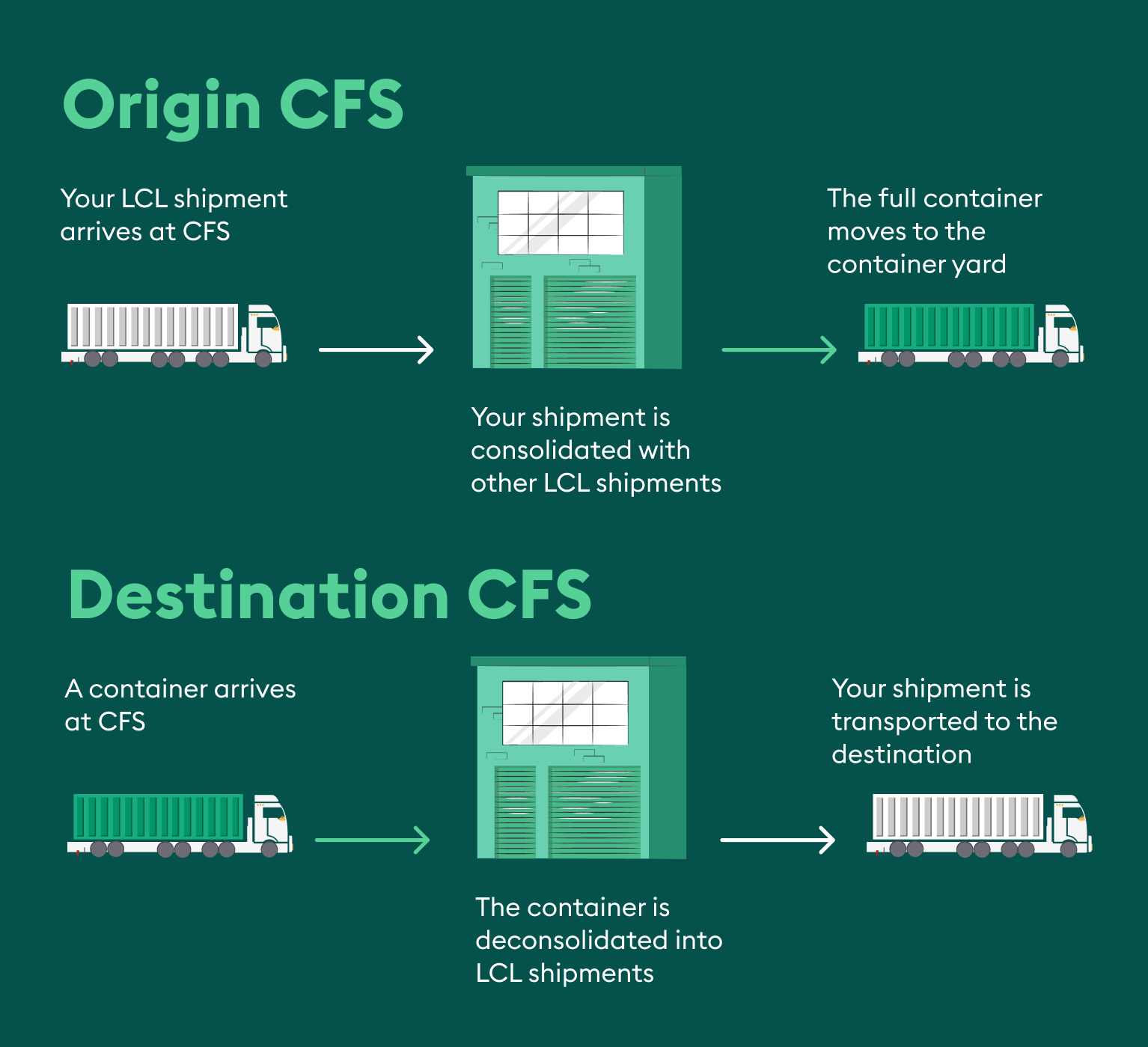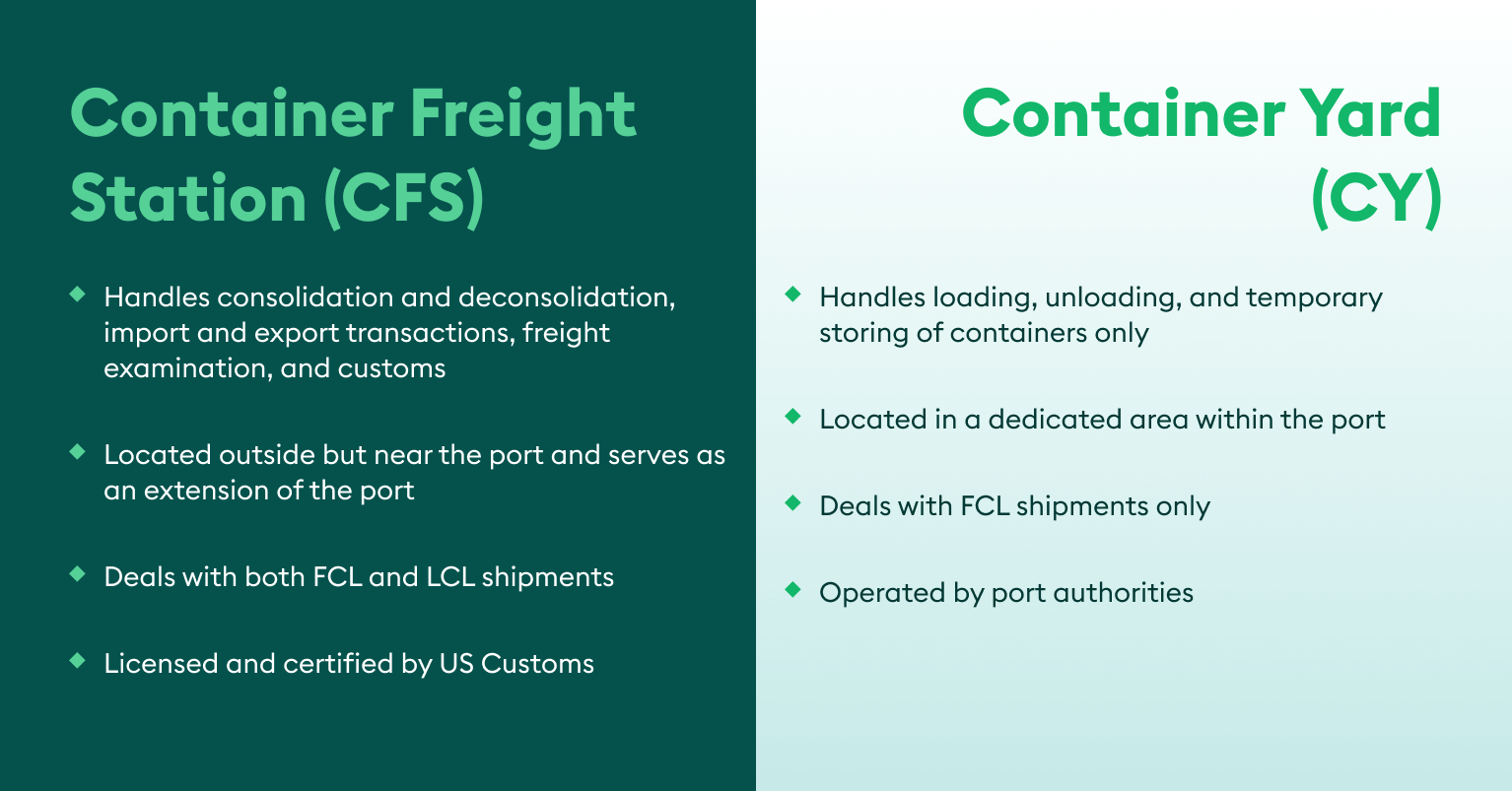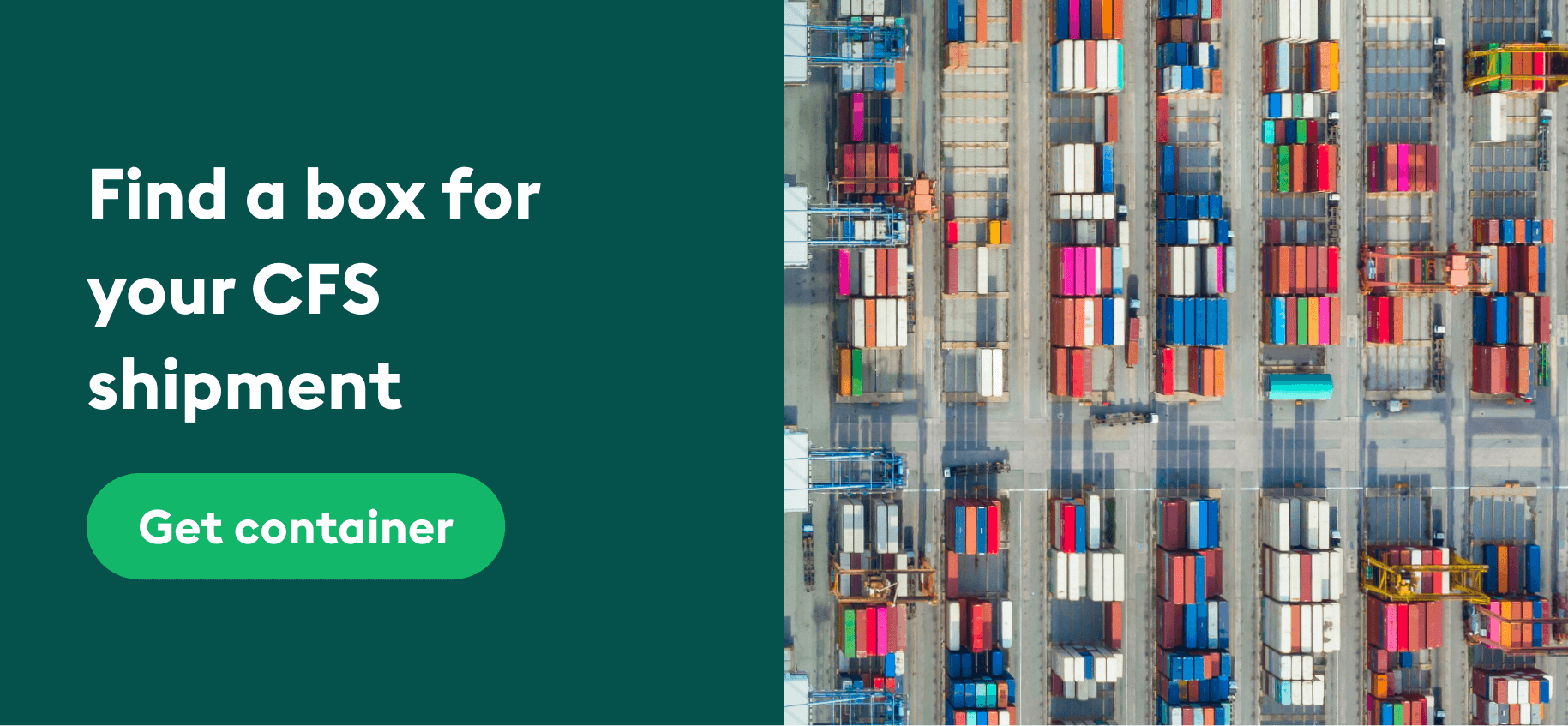Last updated: October 9, 2023
Before CFS shipping became a big part of the industry, the process of transporting goods, especially ones with a smaller load, was a tedious task. It called for your constant attention to get things done as per the procedure. But today, shipping has been reformed, thanks to the introduction of Container Freight Stations (CFS). Know more about the benefits of CFS for your business and also secure a box for your next shipment in 5 easy steps.
CFS Shipping is seeing a significant increase in demand today because of smaller and more specific consignments, rising demand for e-commerce, and the overall growth of less-than-container-load (LCLWhat is less than container load? Less than container load (less than container load, LCL) is a shipping term that refers to the delivery of cargo in smaller quantities than a full container load. A f... More) shipments.
So, if you ship via CFS, your cargo will spend some time at container freight stations (CFS) during shipment, and the station will take care of all your shipping procedures for you.
Keep reading to find out everything CFS shipping takes care of and the numerous benefits it brings to your business.
But before you get there use our public search below to lease containers for CFS shipping at competitive rates. Just enter your pick-up and drop-off locations and container type, and hit the search button. You’ll get your box with just a few clicks from vetted suppliers right away. Try it below!
What is the full meaning of CFS in shipping?
A Container Freight Station (CFS) is a facility used in the shipping industry where cargo is consolidated or de-consolidated and prepared for transport. It acts as a temporary storage and processing area for goods being shipped in containers. CFS plays a crucial role in the logistics and supply chain management, especially in the context of containerized shipping.
CFS in shipping is highly beneficial as it is:
- Cost effective – CFS helps in optimizing container space, reducing the need for multiple shipments, and minimizing transportation costs.
- Time saving – The consolidation and de-consolidation processes at CFS expedite the overall shipping process, leading to faster transit times.
- Customs compliant – Having goods inspected and cleared at the CFS ensures compliance with customs regulations, avoiding delays and complications at the destination.
- Flexible – CFS facilities offer flexibility in managing various types of cargo, accommodating diverse shipping needs.
- Mitigates risk – CFS provides a controlled and secure environment for the temporary storage of goods, reducing the risk of damage or loss during transit.
Container Freight Stations are commonly found close to harbors, within terminals, close to massive warehouses, or near significant railway hubs. Once the cargo is deconsolidated for the individual shippers, the goods will be transported by trucks or trains or picked up by customers.
As for the bills of lading for LCLWhat is less than container load? Less than container load (less than container load, LCL) is a shipping term that refers to the delivery of cargo in smaller quantities than a full container load. A f... More shipments, it’s the shipping line’s bill of lading that is issued. And it includes the words CFS/CFS. This indicates that the shipping line’s accountability starts at the origin CFS and ends at the destination CFS.
What are the functions of a container freight station
The functions of a container freight station are
- Loading and unloading containers.
- Receiving shipments (at origin) and dispatching them (at destination).
- Measuring consignment weight and examining containers.
- Providing temporary storage of empty containers.
- Keeping track of shipments by having a thorough record of the names of importers, exporters, customs agents, and any other relevant parties.
- Formulating a container load plan, i.e., a document with detailed directions on how a shipment should be loaded onto the vessel.
- Consolidation and deconsolidation of cargo.
- Stuffing, sealing, and assigning specific marks and seals to the containers for identification purposes.
- Arranging and rearranging empty containers from container yards.
- Supervising transportation of laden containers to the corresponding port or terminal.
- Regularly ensuring the upkeep, maintenance, and timely servicing of the containers.
- Overseeing the customs clearance procedures while safeguarding the cargo until it’s picked up.
- Using free spaces as a temporary storage facility for cargo.
- Tallying
- Drayage of loaded containers from CFS to the container yard.
- Issuing dock receipts or shipping orders.
How does CFS shipping help your business?
The CFS authorities simplify and take care of the entire shipping process for you thus improving your operations and ensuring timely deliveries. Here’s how CFS shipping aids your business:
Example of CFS during export
If you’re looking to export, it handles everything. You’re only responsible for getting your goods and shipping bill to the station, after that CFS authorities take over.
Your goods and the shipping bill arrive at the station. The cargo is unloaded and the CFS custodian accounts for the arrival of the goods. Then, customs authorities initiate customs clearance procedures. Once that process is completed and the customs authorities issue a shipping bill with “let export order,” CFS begins loading the goods into the container. After which the container is sealed and marked. The CFS authorities then dispatch it to the port/terminal for export.
Example of CFS during import
Your unit reaches the destination CFS, and the station offloads the cargo and sends it for the cargo clearance process. The cargo owner or their clearing agent files a bill of entry. Once the cargo clearance and duty payment are made, it’s forwarded to the customs authority. Customs issues a bill of entry with an “out of charge” order. The CFS custodian then dispatches the cargo to the importer with a gate pass.
The container freight station officials simplify the entire shipping process for all LCLWhat is less than container load? Less than container load (less than container load, LCL) is a shipping term that refers to the delivery of cargo in smaller quantities than a full container load. A f... More and FCL cargos for you. Think of all the time and energy that it saves you and your business!
Plus, the CFS acts as an extension of the port. Thus, helping ports to reduce congestion while streamlining the entire process. This saves your company from incurring costs related to a container rollover which happens for a variety of reasons, one of them being heavily congested ports.
How Container xChange can help you secure a container for CFS shipping
The advantages of the CFS are plenty! So, if you’re ready to secure a unit for CFS shipping we’ve got great deals for you on our platform.
Container xChange is a neutral online marketplace for containers for buying, selling, and leasing containers. On our platform, you get 50,000+ boxes in 2,500+ locations worldwide from 1,500+ vetted members.
Thanks to our market price transparency, you also get competitive, comparable, and negotiable rates on our platform with zero hidden fees. On our dashboard, you can see rates stated upfront. And compare the rates and other terms and conditions to get the best deals.
You can view these rates provided by dependable partners only as we have a thorough mandatory vetting process in place to ensure all members on the platform are credible and safe. Then you can compare the rates and terms, and negotiate directly with the partners. And finally, choose a price that fits you the best. You also get to view the partners’ performance and reviews left by other members who’ve worked with them so you know exactly who you want to work with.
We also offer a payment handling feature – xChange wallet, to ensure all transactions are done under one secure platform with one consolidated invoice only. Plus, with us, you get near real-time tracking of your containers with status updates and tracking alerts – such as ETAsWhat is estimated time of arrival? Estimated time of arrival, commonly known as ETA, is a frequently used term globally to denote the time of coming. In the shipping & logistics industry, it is ... More and misuse warnings.
So come and reap the benefits of our platform at your fingertips and lease a box for your CFS shipping to streamline your operations today by clicking on the banner below.
What is included in CFS shipping charges?
With so many important functions taken care of with CFS shipping, it is clear that container freight stations form a vital link in supply chain operations, hence there are charges associated with these stations. CFS fees typically cover:
- Trucking the container from the port to CFS.
- Loading and unloading of the container.
- Consolidating and deconsolidating of cargo.
- Any necessary palletizing if it’s required for the shipment.
- Documentation management.
- Customs release processes.
- Loading the cargo from the CFS station to the truck picking up the shipment.
- And if there’s a last-mile delivery, CFS shipping also takes care of that in certain cases.
What happens at a Container Freight Station?
What happens at a container freight station can be broken down into two parts: Origin CFS and destination CFS. Both processes are presented in the image below for you to see exactly what happens to your container and cargo at these two points in their journey via the container freight station.
Have a look below.
What is CFS in shipping vs CY in shipping?
Now that you’ve got an overview of CFS shipping, we want to introduce you to another similar-sounding terminology to CFS – CY. Though they seem similar they have very different meanings.
To give you a visual representation of the difference between CFS and CY, we have created an image below.
Secure a container at top rates on Container xChange for CFS shipping
With all your knowledge of CFS shipping and its benefits fortified, it’s time to get your container secured. Let’s take you through the 5-step process on how you can achieve this on our platform.
- Log onto https://www.container-xchange.com/
- Key in your pick-up and drop-off locations and the container type.
- Choose from a list of offers from vetted suppliers under one dashboard.
- Compare and negotiate these offers with the supplier directly via calls or chats and pick a deal that works for you.
- And lease your SOC right away.
So, take your pick from 50,000+ containers and get pricing, tracking, and leasing benefits here that you won’t find on any of your other sourcing channels. Don’t delay in making your container logistics operations smoother and faster with the advantages of CFS shipping and Container xChange’s marketplace; come and lease a container with us right now by clicking the banner below.
CFS shipping: Common FAQs
What is CFS in shipping?
CFS in shipping simply denotes a container freight station which is a warehouse where cargo belonging to various exporters or importers is consolidated or deconsolidated before being shipped. The container freight station will consolidate all consignments going to a specific destination and pack all those cargoes into one container going to that destination.
Is CFS the same as LCL?
No, CFS is not the same as LCLWhat is less than container load? Less than container load (less than container load, LCL) is a shipping term that refers to the delivery of cargo in smaller quantities than a full container load. A f... More. A CFS stands for Container Freight Station. It's a space, usually a large warehouse, that specializes in the consolidation and de-consolidation of cargo. Especially, LCLWhat is less than container load? Less than container load (less than container load, LCL) is a shipping term that refers to the delivery of cargo in smaller quantities than a full container load. A f... More or less than container loadWhat is less than container load? Less than container load (less than container load, LCL) is a shipping term that refers to the delivery of cargo in smaller quantities than a full container load. A f... More cargo. Consolidation is the process of combining multiple LCLWhat is less than container load? Less than container load (less than container load, LCL) is a shipping term that refers to the delivery of cargo in smaller quantities than a full container load. A f... More shipments to form a full container load (FCL) while de-consolidation is its reverse.
What are CFS and CY in shipping?
CFS stands for container freight station and it’s used for LCLWhat is less than container load? Less than container load (less than container load, LCL) is a shipping term that refers to the delivery of cargo in smaller quantities than a full container load. A f... More shipment, and CY stands for Container Yard and it’s used for FCL shipment.






